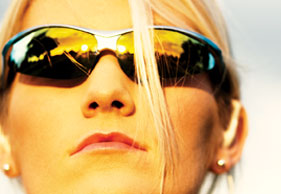We tend to focus on our legs and feet as the most important body parts for our running. The lower back and core stomach muscles get a bit of attention now and then, and sometimes the upper body and arms also feature… But how often do we think about our eyes? Not often enough, because they are vitally important to our running.
While running the other day in bright sunshine, a clubmate and I were discussing sunglasses, since I was wearing a pair and he wasn’t. He mentioned that he really should get a pair of running sunglasses, as he was squinting quite badly in the glare. I replied that he needed sunglasses not only for the glare, but also to protect his eyes from all the UV radiation emitted by the sun, and that he should actually wear sunglasses every time he goes outside, not just when running.
I was told this by Dr Sherylle Calder of the Sports Science Institute of South Africa in Cape Town, when I interviewed her about vision and running. Sherylle is a world-renowned vision specialist who has worked with many top sportspeople and teams, including the 2007 Rugby World Cup-winning Springboks, to improve their reaction speed, hand-eye co-ordination and balance through visual training and exercises. Her focus is on how visual training can benefit one’s sports performance, but we also spoke about eye protection, specifically about wearing sunglasses.
ALWAYS COVER UP
Sherylle told me that, “Unfortunately, many sports participants still think that safety precautions are only necessary in extreme or contact sports, but in running, one of the most important aspects to consider is the protection of the eyes, because runners’ eyes are often exposed to bright light and UV radiation.”
She explained that there are three types of UV radiation produced by the sun – A, B and C. The ozone layer absorbs UV C radiation, so it poses no threat to us – so long as there is still an ozone layer, of course – but the A and B types penetrate the ozone and pose a threat to us when we are outdoors. “The longer your eyes are exposed to UV radiation, the greater the risk of you developing problems such as glaucoma, a condition caused by increased pressure of the fluid within the eyeball. You could also develop cataracts, which is clouding of the lenses.”
According to the experts, we should all wear sunglasses every time we go outside, which means when we run as well. The problem is that some runners don’t like running with sunglasses, because the glasses bounce, slip or worse, fog up. Most sunglasses manufacturers are aware of these problems nowadays and thus have introduced design technology and features to overcome these problems.
“The top ranges offer sunglasses with improved fit and performance, making them far more suitable for running. The frames are more durable, and many have venting systems to eliminate fogging. They also have thermogrip nose-pads, ear-pieces and temples to ensure a snugger, non-slip fit,” explains Sherylle. “Also, polycarbonate lenses are better for running. They are shatterproof, scratch-resistant and fog up less easily than glass or plastic lenses. And specialist running pairs often offer interchangeable lens options for different light conditions.”
BOTTOM LINE
My clubmate then asked the proverbial million dollar question: “So do I need to go buy expensive sunglasses that cost more than my running shoes or can I get away with a cheaper pair?” The answer, according to Sherylle, is that, “Some of the cheapest sunglasses offer adequate protection and undistorted vision. The big difference is that many of these cheaper sunglasses are not designed for running.”
So, when buying sunglasses to run with, make sure they meet all of these requirements:
1 Block out all UV A and B radiation.
2 Screen out between 75% and 90% of visible light – lenses that ‘wrap’ your face are best.
3 Fit your face comfortably and snugly, but not too closely.
4 Don’t bounce or move when you run or jump.
5 Don’t fog up when you sweat – look for anti-fogging vents or ‘flying lenses’ that are mounted with gaps between lens and frame.
6 Don’t slip when you sweat – look for ‘sticky rubber’ on the nose-piece and ear-pieces.
And of course, they need to look good on you, too. But don’t compromise on performance and protection just to look more fashionable out on the road! You need to protect those peepers.


